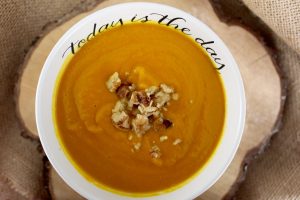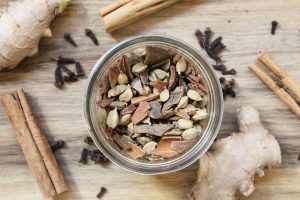Fall is a time of transition. Not only does the weather get colder, but our schedules change. It seems that it’s the time of year when we get busier, but the days get shorter. Kids go back to school, and routines change. Making it onto your mat every day can seem like a monumental feat. Many people also experience a dip in their mood as it hits them that winter is just around the corner.
What you might not realize, is that when the season’s change, subtly, so do we. As these shifts happen, it’s important to not only bring awareness to them but make changes in both our diet and lifestyle to ensure optimal health.
[holler-upgrade id=”474″ link=”Download now.”]Take our Dosha Quiz.[/holler-upgrade]
According to Ayurveda – the sister science of yoga – having a seasonal routine is a key component of our health and well-being. By making changes to our lifestyle choices as the season’s change, we can actually help eliminate or reduce some seasonal imbalances.
If you aren’t overly familiar with Ayurveda, I’ll go over some basics.
Ayurveda suggests that we are all comprised of a combination of different biological energies found throughout the body and mind, which are referred to as Doshas. The doshas all have different qualities, and while each one is present in our body, mind, and environment, some doshas are more dominant than others.
A Brief Breakdown of the Dosha’s:
Vata
Vata has the qualities of space and air. It loosely translates to “that which moves things.” Vata is concerned with movement – of the body, and mind. When balanced, Vata can improve physical activity, creativity, and expression. If Vata is imbalanced, we may feel gassy or bloated in our physical body, and anxious and uneasy in the mind.
Pitta
Pitta has the qualities of Fire and Water. It loosely translates to “That which cooks.” Pitta is concerned with digestion, controls our metabolic activities, and regulates body temperatures. If you are prone to being overly hot, chances are you are a pitta type! Pitta also manifests in the mind as courage, willpower, and determination. If Pitta is imbalanced, we may experience poor digestion and excess heat in the body. In the mind, we may experience jealousy, anger, and resentment.
Kapha
Kapha has the qualities of water and earth. It loosely translates to “that which sticks.” Kapha is concerned with building the structures of the body and can be thought of as the glue or lubricant that holds the body together. When Kapha is balanced, we feel grounded, calm and strong. When Kapha is imbalanced we may feel overly heavy, lethargic and lazy.
We are in Vata Season
While each season manifests differently in each part of the world, fall is typically thought of as Vata season. It is here in Toronto at least. When we shift from summer which is hot, and sticky, to fall which is usually cool, windy, dry, it can throw our Vata into excess and may contribute to us feeling out of whack. So all those Vata imbalances I mentioned earlier like excess bloat, gas, anxiety, and uneasiness, are all things that can become exacerbated in the fall if we aren’t careful.
That’s why we’ve come up with a few simple changes you can make to your diet and lifestyle this fall to help you combat the effects of this Vata season.
A Simple Ayurvedic Guide to Fall Wellness
1. Shift from cooling foods to warming foods

In the summertime – which is Pitta season – you may have noticed that you craved things like salad, cold-pressed juices, fruits. You probably craved snacks that had a cooling effect on the body. However, as we shift into fall, we want to start to favor warming, grounding foods. What’s awesome is that our environment naturally produces these grounding foods for us! Favouring seasonal fall veggies like squash, carrots, and pumpkin will have a grounding effect. Prepared foods like warm soup, Dal, and Kitchari will also help you feel nourished in both your mind and body. You can also check out some of our favorite fall vegan recipes for some inspiration.
2. Spice it up!

Incorporating spices into your foods is a great way to calm the Vata this fall. This doesn’t just mean topping your food with hot chili peppers, and cayenne. Things like turmeric, cinnamon, cloves, ginger, nutmeg, and garam masala are great spices that will promote grounding this fall.
3. Perform Abhyanga (Self-Massage)

Performing self-massage, at least weekly, can really support the nervous system in calming down during this transitional season. In the summer it may have been best to use a cooler oil (such as coconut) for Abhyanga, but as we move into fall, favoring a warmer oil such as sesame would be best. This one from Banyan Botanicals is my personal fall favorite. Abhyanga is a great way to unwind after a stressful work week.
4. Show up for your practice (yes, every day!)

While the shorter days and the pitch black sky that accompanies your 5 am practice alarm might tempt you to skip practice, don’t. Resist the urge! This practice is so grounding. When you commit to a daily practice, it becomes a source of familiarity. No matter how hard it gets (physically or emotionally) it is a constant in your life. This consistency is a powerful source of stability, which supports the body and mind during Vata season. All you need to do is show up on your mat every day. Plus, if you’re an AYCT practitioner, there are so many opportunities to practice with our schedule!
5. Practice Svadhyaya Daily

Svdahyaya – or self-reflection – is a great way to ground yourself this fall. Some simple tools to help deepen your self-reflection outside of your daily yoga practice are journalling, seated meditation, or spending some quiet time by yourself ideally in nature. Set aside 10-15 minutes a day for whichever type of reflection calls out to you, and begin to notice the subtle shifts that take place in both your body and mind.
These are just a couple ways that you can support your body and mind in feeling more grounded this fall. If you’re looking for some more tips on what foods you should eat, we’ve created this simple swaps guide for fall below.
Do you have any other grounding practices that you do during the fall? We’d love to hear from you! Let us know below in the comments, or share on Facebook or Instagram.


What a beautiful post and so spot on! Fall is in the air! A crispness is starting to settle in as the cool and dry qualities of Vata dosha begin to dominate the season. Vata dosha, comprised of Ether and Air elements, also brings us mobility and lightness. These qualities can be seen in nature when we observe tree branches dancing in the cool wind and dry leaves gracefully floating down to softly rest upon the land. We may experience these same qualities within ourselves as restlessness, anxious thoughts, dryness in our joints, and irregular digestion. To restore balance during this season of transition, we can ground our energy back to the Earth with the following practices: read the entire article here – https://www.paavaniayurveda.com/ayurveda-seasons-fall-part-2/
Thanks so much Paul!